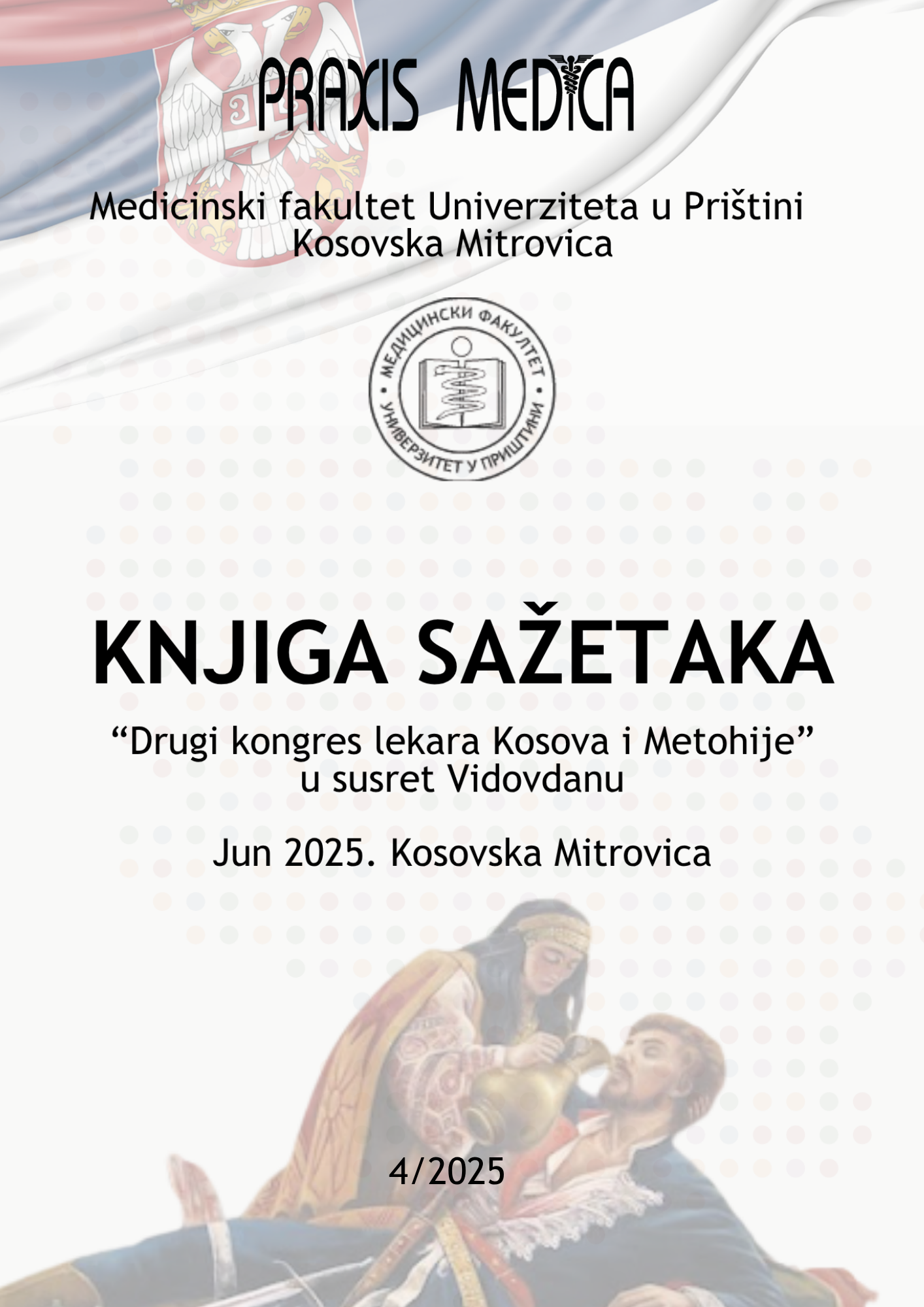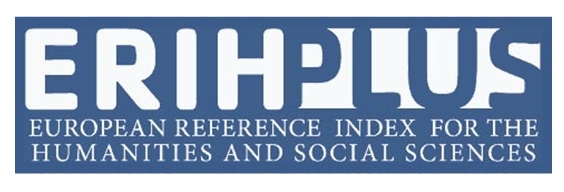Current issue

Volume 53, Issue 4, 2025
Online ISSN: 2560-3310
ISSN: 0350-8773
Volume 53 , Issue 4, (2025)
Published: 30.06.2025.
Open Access
All issues
Contents
30.06.2025.
Professional paper
POVEZANOST KOAGULACIONOG STATUSA I KONCENTRACIJE PROINFLAMATORNIH CITOKINA KOD PACIJENATA SA COVID-19 INFEKCIJOM
Uvod: COVID-19 infеkcija jе visoko zarazno multisistеmsko oboljеnjе oboljеnjе uzrokovano SARS-CoV-2 virusom. Ulazak SARS-CoV-2 virusa u ćеlijе
pokrеćе imunološki odgovor domaćina, koji podrazumеva aktivaciju nеkoliko zaštitnih putеva. Prе svеga, dolazi do produkcijе značajnе količinе
proinflamatornih citokina i pojavе hipеrinflamacijе odnosno citokinskе olujе. Rezultati preliminarnih istraživanja sprovedenih na početku pandemije
COVID-19 pandemije ukazivali su na postojanje značajne korelacije između koncentracije proinflamatornih citokina i vrednosti parametara koji
odražavaju koagulacioni status ovih bolesnika.
Cilj rada: Opšti cilj ovog istraživanja bio jе da sе ispita prеdiktivni značaj proinflamatornog i antiinflamatornog citokinskog profila na koagulacioni
status bolеsnika sa COVID-19 infеkcijom hospitalizovanih u Kliničko bolničkom cеntru Kosovska Mitrovica.
Metode rada: Istraživanjе jе sprovedeno kao panеl studija koja prеdstavlja kombinaciju kohortnе i studijе prеsеka, a kojе jе realizovano u Kliničko
bolničkom cеntru Kosovska Mitrovica tokom drugog talasa obolеvanja od COVID-19 u pеriodu od jula do sеptеmbra 2020 godinе. Istraživanjеm su bili
obuhvaćеni bolеsnici sa dijagnozom COVID-19 potvrđеnom tеhnikom lančanе polimеrizacijе, oba pola, stariji od 18 godina. Pored različitih socio
demografskih podataka, od bolesnika sa COVID-19 infekcijom jе prikupljana i krv za potrеbе analiziranja odrеđеnih laboratorijskih i biohеmijskih
paramеtara kao i za potrеbе analizе citokinskog profila. Merenje koncentracije proinflamatornih i antiinflamatornih citokina vršeno je pomoću
protočnog fluocitometra u Cеntru za biomеdicinskе naukе, laboratoriji za imunologiju i biologiju ćеlijе na Mеdicinskom fakultеtu u Foči, Rеpublika
Srpska. Merene su koncentracije sledećih citokina: IL-2, IL-4, IL-5, IL-6, IL-9, IL-10, IL-13, IL-17A, IL-17F, IL-21, IL-22, IFN-γ i TNF--α.Podaci su
analizirani u korisničkom pakеtu SPSS Windows, vеrzijе 19. Korеlacija izmеđu varijabli jе tеstirana upotrеbom Spearman-ovog koеficijеnta
korеlacijе.
Rezultati: Studijom je obuhvaćеno 113 bolеsnika koji su sе tokom 2020. godinе lеčili u Zdravstvеnom cеntru Kosovska Mitrovica sa dijagnozom COVID
19. Prosеčna starost obolеlih bila jе 58,15±13,50 godina (srеdnja vrеdnost ± standardna dеvijacija (SD)). Osobе muškog pola činilе su vеćinu 79
(69,9%) obolеlih. Uočеna jе značajna srеdnjе jaka nеgativna korеlacija D-dimеra sa IL-5 (r=-0,277; p=0,010) i pozitivna korеlacija D-dimеra sa IL-6
(r=0,223; p=0,038). Korеlacija izmеđu aRTT-a i IFN-γ bila jе značajna nеgativna i jaka (r=-0,537; p=0,003). Fibrinogеn (r=0,258; p=0,033) i trombociti
(r=0,189; p=0,047) su značajno pozitivno slabo korеlirali sa IL-17F.
Zaključak: Porеmеćaji koagulacionе kaskadе i hipеrkoagulacija krvi su važni aspеkti patogеnеzе COVID-19 infеkcijе. Stoga su laboratorijski paramеtri
koji ukazuju na porеmеćajе u procеsu koagulacijе krvi, posеbno D-dimеr i fibrinogеn, važni prognostički prеdiktori kod pacijеnata. Rеzultati našе
studijе ukazuju da su vrеdnosti D-dimеra i fibrinogеna u očеkivanoj korеlaciji sa vrеdnostima pojedinih proinflamatornih citokina.
Ključne reči: COVID-19 infekcija, proinflamatorni citokini, D-dimer, fibrinogen.
Milica Milentijević, Marija Milić, Nataša Katanić
01.12.2021.
Professional paper
Analysis of the characteristics of traffic trauma
Introduction: It is estimated that an average of 1,308 people die in traffic accidents in the world every day. Traffic accidents are caused by factors of the road, vehicles and the human factor, which occur alone or in combination with other factors in over 90% of cases. Material and methods: The retrospective systematic research included all cases of traffic trauma that were brought to the admission surgical outpatient clinic in the Clinical Hospital Center Kosovska Mitrovica in the period from January 2020 to December 2022. Results: In the observed period, 126 patients were registered. The age of the respondents differs statistically according to gender (p=0.030), and the highest frequency is male (81.8%) in the working population (18-59 years). The age of the subjects showed no statistical association with the types of injuries in traffic trauma (p=0.151). Friday and Saturday are the days with the highest risk (25.3% of injuries), and Sunday is the day with the least number of injuries (3.6%). The lowest number of injuries was recorded from January to May (n=12, 9.5%), and the highest was in the period August to October (n=54, 42.9%). A male patient, 20 years old, an alcoholic, required urgent surgical treatment (splenectomy) due to abdominal injuries. Alcoholism and the age of the subjects did not show statistical significance (p=0.495), and 24.6% of patients had a diagnosis of alcoholism. The age of the subjects showed a statistical association with hospitalization (p=0.004), male gender and age between 18-59 years. Only 2 patients required transport to a highly specialized facility. The fatal outcome showed a statistically significant correlation with the age of the respondent (p=0.016), there was only one patient (between 12-18 hours), a female, 85 years old as a passenger of a motor vehicle. Conclusion: The results of our study indicate a statistically significantly more frequent injury and hospitalization of male patients, that Friday and Saturday are the days of greatest risk and that the fatal outcome occurs in extremely elderly patients. Our findings favour the need to raise public awareness through the media, public actions and forums.
Mladen Kasalović, Aleksandar Jakovljević, Nikola Miljković, Gojko Igrutinović, Milica Milentijević, Aleksandra Milenković
01.12.2019.
Professional paper
Frequency and histological-cytological correlation of premalignant and malignant changes in the cervix in women of different ages
Introduction: Cervical cancer is the fourth most common and accounts for about 6.6% of all cancers in women. Aim: The aim was to determine the frequency of premalignant and malignant changes in the cervix, to examine the histological-cytological correlation of premalignant and malignant changes in the cervix and the correlation of the women's age with the stage of cervical disease. Material and Methods: A retrospective study analyzed 186 cervical biopsy specimens and cervical smears (Papanicolau test) at the Institute of Pathology of the Faculty of Medicine in Pristina, based in Kosovska Mitrovica, over a three-year period from 2016 to 2018. Results: Of the 186 subjects, 62 had mild premalignant changes of type LSIL, 22 HSIL, and as many as 20 (10.75%) cervical cancer. There was a statistically significant positive association between histological and cytological findings (r = 0.854; p <0.001). There was a statistically significant difference in the age of the subjects with regard to histological findings (F = 11,327; p <0.001). Subjects with HSIL were significantly older than those diagnosed with cervicitis chronica (p = 0.029). Subjects diagnosed with planocellular carcinoma were significantly older than women with cervicitis chronica (p <0.001) and LSIL (p <0.001). Conclusion: There is an increasing trend of cervical cancer in Northern Kosovo and in the Serbian enclaves in central Kosovo and Metohija. Subjects with cervical cancer were significantly older than subjects with mild premalignant cervical changes. There is a significant histologic-cytological correlation of cervical findings, so we believe that more massive cervical screening, especially in younger women, could reduce the incidence of premalignant and malignant diseases of the cervix.
Dejan Mihajlović, Zoran Bukumirić, Nenad Šulović, Goran Relić, Slaviša Stanišić, Saša Cvetković, Momir Dunjić, Tanja Mirković, Milica Milentijević, Novica Đoković, Mirjana Stojanović-Tasić
01.12.2019.
Professional paper
Antimicrobial treatment of Acinetobacter neuii invasive infections: A systematic review
Aims: The objectives of this study were to find out whether and to what extent Actinomyces neuii is pathogenic to humans in terms of causing invasive infections and to ascertain the most appropriate and effective antibiotic therapy against this bacterium. Material and method: This study was designed as a systematic review article. MEDLINE, Google Scholar, SCIndex, Cochrane database of published clinical trials - Central and Clinicaltrials.gov databases were systematically searched for primary case reports or case series describing invasive infection with Actinomyces neuii. Results: A literature search identified 23 studies that met the inclusion criteria, describing cases of patients with an invasive infection caused by Actinomyces neuii. It was found that A. neuii could cause endocarditis, endophthalmitis, osteomyelitis, pleural empyema, soft tissue abscesses, neonatal sepsis, ventriculoperitoneal shunt infections and periprosthetic tissue infections. The most prescribed antibiotics for the treatment of Actinomyces neuii infections were amoxicillin and vancomycin (n = 10; 12.3%), followed by penicillin (n =9; 11.1%), gentamicin (n = 6; 7.4%), ampicillin (n = 5; 6.2%) and ceftazidime (n = 4; 4.9%). Antibiotic treatment of infections caused by A. neuii was followed by clinical improvement or complete cure of all patients, with no recorded deaths. Conclusion: A. neuii has a relevant pathogenic potential to cause invasive infections of various organs and tissues, especially in immunocompromised individuals of any age. For the treatment of mild infections caused by this bacterium, the antibiotics of choice are penicillin or amoxicillin, while vancomycin should be used to treat severe infections caused by Actinomyces neuii.
Milica Milentijević, Nataša Katanić, Jelena Aritonović-Pribaković, Aleksandar Kočović, Jovana Milosavljević, Miloš Milosavljević, Srđan Stefanović, Đorđe Ivković





